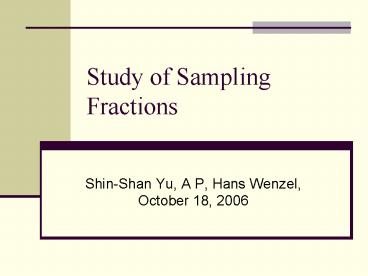Study of Sampling Fractions PowerPoint PPT Presentation
1 / 15
Title: Study of Sampling Fractions
1
Study of Sampling Fractions
- Shin-Shan Yu, A P, Hans Wenzel, October 18, 2006
2
Definitions
- Construct a sampling calorimeter from alternating
layers of absorber, thickness tabs and active
material, thickness tact. Both active and
absorber are made of the same material (lead
glass) - Sampling fraction SF tact /(tabs tact)
represents the fraction of the total energy
deposition (on average) deposited in the active
layers. - Estimate of the total energy deposition from the
corrected observed energy in the active layers
has an additional contribution due to sampling
fluctuations fluctuations of the sharing of
total energy between the absorber and active
layers - 20 GeV pion beam
tact
tabs
3
Fluctuations of the energy deposition in the
active layer Sampling Fluctuations
4
Sampling Fluctuations Contribution to Energy
Resolution
5
Fluctuations of the energy deposition in the
Cherenkov radiator Sampling Fluctuations
6
Energy Resolution
7
Corrected response
8
Response and Resolution as a Function of Sampling
Fraction
- Corrected response is not a simple function of
the sampling fraction, when active layer is small - Physics??
- GEANT4 feature?
- Sampling fraction represent a significant
contribution to the energy resolution when the
cherenkov radiator thickness is large (gt2.5 cm
or so)
9
Response and Resolution as a Function of the
Active Layer Thickness
- Corrected response problem at small active layer
thickness seems to be related to the absolute
thickness of the active layer and not to the
sampling fraction
10
How Big a Test Calorimeter?
- Hadron calorimeters are large (m3), hence
expensive. Cant afford to be bigger than
necessary. - (if we build it) we want to demonstrate good
energy resolution (20-30)/sqrt(E), that is
2-3 energy resolution at 100 GeV. If the
calorimeter is not long/wide enough there will be
some energy leakage from the calorimeter and its
fluctuations will contribute to the energy
resolution. Need containment 98 or better.
11
How Long a Calorimeter
- Need 2.5-3 m long lead glass
- Blue Cherenkov
- Red ionization
12
How Wide a Calorimeter?
- Need 1m wide test module
- Red ionization
- Blue Cherenkov
13
Available Building Blocks
- E70 experiment (Lederman, upsilon) SF5 lead
glass blocks 6x6x16 - 6 is far too thick. Optimal absorber thickness
needs study (sampling fluctuations) 3 (thick)?
2(thin)? Options - 3 m 120
- 40 thick planes
- 60 thin planes
- 7 x 6 105 cm wide
- 3212 110 cm tall
- 18 pixels per plane
- Fundamental unit lead glass
- scintillator plate
- Transverse segmentation
- Common LG and scintillator
- Is 6x16 sufficient?
14
Readout?
- Assume LG block and the scintillator plates are
read out via a single waveshifting fiber (light
collection efficiency and uniformity to be
demonstrated) - Channel count 18 x 2 x 40 (60) 1440 (2160)
- Assume Hamamatsu 5800-M64 phototube (?) ? need
25(35) tubes - Electronics?
- DAQ?
15
Cutting the Lead Glass Blocks
- Cut along the long axis
- Diamond band saw
- Water-jet (with abrasives)
- Initial vendor contacts promising
- Surface quality do cut surfaces need to be
polished (manpower cost) - Need to find out what the surface quality is
- Need to find out what is the acceptable surface
quality

